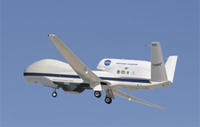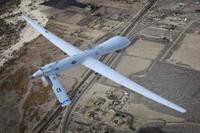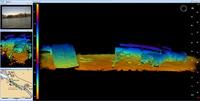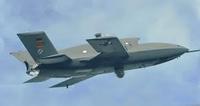-
Nexans shows its anti-theft cable solutions

Nexans is showing its new anti-theft cable solutions at InnoTrans, which opened yesterday in Berlin; the solution promises to help network operators reduce the high volume of copper cables theft along their railway networks
-
-
More cyber-secure UAVs
The software that runs complex military systems such as UAVs contains tens of thousands of lines of code; this code is designed by human beings, and human beings make mistakes; DARPA wants military systems to be run by fail-safe software, ad for this purpose has created the High-Assurance Cyber Military Systems (HACMS) program; Rockwell Collins has been selected as the prime contractor for the unmanned air vehicle portion of the HACMS
-
-
DHS submersible Pluto mimics the real narco-subs
In the early 1990s, South American drug cartels came up with a new tactic to transport narcotics destined for the United States: small, radar-dodging, self-propelled, semi-submersibles (SPSSs); better to address the submersible problem, DHS Science and Technology Directorate created its own submersible and called it Pluto, after the planet which is difficult to spot
-
-
Canada funds digital technology to enhance maritime security, surveillance
New funding will allow exactEarth to improve its ability to locate more than 80,000 ships daily anywhere around the world and transmit this information quickly to its customers; this data is used within Canada and globally for a number of purposes, including enhancing maritime security and surveillance as well as search and rescue support
-
-
Apple rejects app which tracks drone strikes against militants
Apple has rejected an app, developed by a New York student, which tracks U.S. drone strikes in Pakistan; Apple said the app violated rule 16.1 of its guidelines, which bans “excessively objectionable or crude content”
-
-
DHS funds more tests of autonomous power buoy for ocean surveillance

Ocean Power Technologies (OPT) has entered into an agreement with DHS Science & Technology Directorate to perform a new round of in-ocean tests on the company’s Autonomous PowerBuoy to demonstrate its use for ocean surveillance
-
-
Law-enforcement agencies eager for Web-surveillance tools

Private technology firms are pitching software capable of analyzing large swaths of the Internet to local law enforcement looking for ways to stop the next mass shooting or domestic terrorist event before it happens; police departments hope the software will help them detect online information from terrorists, traffickers, pedophiles, and rioters
-
-
Drones being used to track hurricanes

Federal hurricane trackers will start experimenting with unmanned boats and aircrafts to learn more about how to anticipate and track the movements of hurricanes; NASAand the National Oceanic and Atmospheric Administration(NOAA) are teaming up and using a pair of military-surplus Global Hawk spy drones, which are known more for spying on battlefields than chasing storms
-
-
Industry fights Pentagon efforts to restrict exporting of infrared products
The global market for infrared technology products will be worth about $2.6 billion dollars by 2017; the technology can be used for commercial products such as automotive, surveillance, and security industries – and is heavily used by the military; three major U.S. infrared equipment makers fight the Pentagon’s efforts to restrict exports of devices based on the technology for fear these devices may enhance the military capabilities of adversaries of the United States
-
-
U.S. testing blimps, surveillance towers on Mexican border
Last year, the U.S. government ended SBInet, a major and unsuccessful attempt to build a virtual fence along the border that cost nearly $1 billion before it was killed; DHS is now testing aerostats, and an 80-foot tower with similar surveillance capabilities, for border security as part of an effort to exploit technologies that have been used in the wars in Iraq and Afghanistan
-
-
Do drones increase the likelihood of war by lowering its cost?

A leading Australian applied ethicist says engineers should stop working on killer robots and kick the habit of military funding; the professor said military robots are making war more likely by lowering the threshold of conflict
-
-
NYPD monitoring of Muslim communities did not produce a single terrorist lead

An NYPDunit which gathers information on Muslim communities and businesses in order to uncover links to terrorist plots has been unable to do so in six years of engaging in monitoring Muslim communities in New York and New Jersey
-
-
Y-12 and operator error
Three anti-nuclear activists, led by an 82-year old nun, breached the perimeter security system of the supposedly highly secure Y-2 nuclear facility at Oak Ridge, Tennessee, where nuclear weapons components are manufactured (note that the Oak Ridge National Laboratory [ONRL] is not affiliated with the Y-12 National Security Complex); they then spent several hours in a secure area of the facility, leisurely spray-painting slogans on the facility’s walls – without the facility’s security staff, or the sophisticated $500 million security cameras and sensors, detecting them; to understand what happened at Y-2, we must accept that operator error is an essential problem in national security, and that the problem is pervasive and normal; the only way to deal with the operator error phenomenon is to build redundancies into the system
-
-
Long Beach Police Department purchases underwater inspection system for port

The Port of Long Beach is the second busiest seaport in the United States and is a major gateway for trade with Asia, handling more than six million containers annually; to enhance port security, the City of Long Beach Police Department has purchased an Underwater Inspection System (UIS) from Cod Octopus
-
-
Drone use spreads to more areas and missions

As security challenges in the United State and around the globe change, many countries have one thing in common: unmanned drones will be a significant part of the future of security; advancements in technology are driving the use of UAVs into newareas
-
- All
- Regional
- Water
- Biometrics
- Borders/Immig
- Business
- Cybersecurity
- Detection
- Disasters
- Government
- Infrastructure
- International
- Public health
- Public Safety
- Communication interoperabillity
- Emergency services
- Emergency medical services
- Fire
- First response
- IEDs
- Law Enforcement
- Law Enforcement Technology
- Military technology
- Nonlethal weapons
- Nuclear weapons
- Personal protection equipment
- Police
- Notification /alert systems
- Situational awareness
- Weapons systems
- Sci-Tech
- Sector Reports
- Surveillance
- Transportation
Advertising & Marketing: advertise@newswirepubs.com
Editorial: editor@newswirepubs.com
General: info@newswirepubs.com
2010-2011 © News Wire Publications, LLC News Wire Publications, LLC
220 Old Country Road | Suite 200 | Mineola | New York | 11501
Permissions and Policies
Editorial: editor@newswirepubs.com
General: info@newswirepubs.com
2010-2011 © News Wire Publications, LLC News Wire Publications, LLC
220 Old Country Road | Suite 200 | Mineola | New York | 11501
Permissions and Policies
